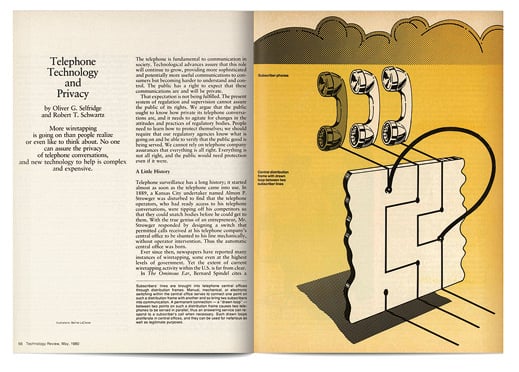Who’s Listening to Your Calls?
Excerpted from “Telephone Technology and Privacy,” by Oliver G. Selfridge and Robert T. Schwartz, in the May 1980 issue of Technology Review.

The telephone is fundamental to communication in society. The public has a right to expect that these communications are and will be private. That expectation is not being fulfilled. We cannot rely on telephone company assurances that everything is all right. Everything is not all right, and the public would need protection even if it were.
Perhaps 50 percent of U.S. telephones are now served by electronic switching systems (ESS), in which messages are transmitted electronically under computer control. Soon after the first electronic switching system exchanges went into service in 1966, we discovered that the ‘test board’ typically associated with an ESS exchange could become a powerful tool to an eavesdropper.
The Wall Street Journal, for example (October 5, 1973), quoted a New Jersey assistant prosecutor: ‘We use a system where you can effectively sit in your home and monitor any phone in the country. You’ll hear everything that transpires over that number.’
The general effect of this new technology is to widen the gap between the communications elite and the public. Most people can easily understand a cord patchboard, in which an operator sits and plugs people’s wires in where lights shine. But few understand a computer program that does the same thing in vastly more complex and comprehensive ways.
With such advances must come an increasingly alert public. People must abandon the attitude that ‘it may be true, but it doesn’t concern me, and I don’t care if my phone is tapped.’ That is said by people who are fairly, if perhaps falsely, sure that their telephones are not tapped. If they discovered that their conversations were being overheard and transcribed, they would almost certainly be outraged.
Keep Reading
Most Popular
Large language models can do jaw-dropping things. But nobody knows exactly why.
And that's a problem. Figuring it out is one of the biggest scientific puzzles of our time and a crucial step towards controlling more powerful future models.
The problem with plug-in hybrids? Their drivers.
Plug-in hybrids are often sold as a transition to EVs, but new data from Europe shows we’re still underestimating the emissions they produce.
Google DeepMind’s new generative model makes Super Mario–like games from scratch
Genie learns how to control games by watching hours and hours of video. It could help train next-gen robots too.
How scientists traced a mysterious covid case back to six toilets
When wastewater surveillance turns into a hunt for a single infected individual, the ethics get tricky.
Stay connected
Get the latest updates from
MIT Technology Review
Discover special offers, top stories, upcoming events, and more.